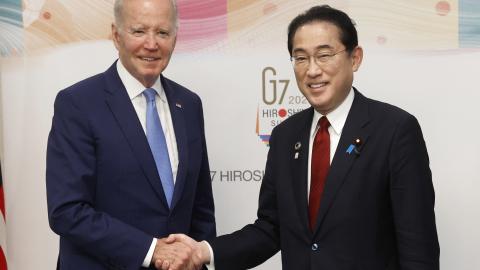The strength of the U.S.-Japan alliance is unprecedented. Despite ongoing leadership changes in both democracies, the alliance enjoys robust support in Tokyo, Washington and elsewhere.
When President Biden and Japanese Prime Minister Fumio Kishida met during last month’s G7 summit in Hiroshima, Biden correctly described the U.S.-Japan alliance as the cornerstone of peace and prosperity in the Indo-Pacific. The United States is, in fact, Japan’s third-largest trading partner, and Japan ranks as the fourth-largest trading partner of the U.S.
The U.S. and Japan have recently cooperated on important security, diplomatic and economic issues. In the security domain, the United States and Japan mobilized a broad coalition against Russian aggression in Ukraine, providing a model for how the democracies could respond to military aggression against Taiwan or Japan’s Senkaku Islands.
Through vigorous diplomacy, Tokyo has rallied other Asian countries in favor of the rules-based international order and against challenges from China, Russia, North Korea and other revisionist states. The Japanese government has even broken with decades of precedent by raising defense spending well above the longstanding national cap of 1 percent of gross domestic product.
In the realm of economics, the U.S. and Japan have also expanded and deepened their cooperation against predatory Chinese commercial practices with new agreements on strategic minerals, semiconductor export controls, electric vehicles, and supply chain security. The U.S. reduced tariffs on Japanese steel imports, whereas Japanese authorities have lowered tariffs on U.S. beef and pork imports. In line with its new security initiatives, the Japanese government will purchase substantially more advanced U.S. weapons systems and launch new defense industrial projects with U.S. partners.
Their landmark 2019 U.S.-Japan Digital Trade Agreement committed the two governments to non-discriminatory treatment of each other’s computer programs, console games and other digital products. The March 2023 session of the U.S.-Japan Policy Cooperation Dialogue on the Internet Economy issued a statement affirming joint initiatives on 5G connectivity and artificial intelligence. They appropriately renamed this body the U.S.-Japan Dialogue on Digital Economy “to reflect the increasing digitalization of societies and its importance as a foundation to support economic development and growth.”
Japanese strategists have developed the conceptual foundation for this enhanced cooperation in their novel “integrated security” approach, which seeks to maximize security through integrated economic and military initiatives. This approach complements the Pentagon’s “integrated deterrence” doctrine.
Still, progress in U.S.-Japanese economic cooperation has lagged behind that in the economic, security and diplomatic domains. As one expert noted, “trade liberalization is the one area where the United States and Japan have not been able to move in sync. Their closer alignment on defense and diplomacy only makes this contrast starker.”
Though U.S. and Japanese cybersecurity collaboration is improving, their cooperation regarding commercial digital products is lagging, despite the growing threat from China. By leveraging state subsidies, cyber espionage of foreign technologies, and illicit payouts to foreign officials and company insiders, Chinese companies are making progress in realizing their government’s goal of surpassing the U.S., Japan and other countries in critical high-tech sectors.
Both the Biden and Kishida administrations want the U.S. to lead a superior Indo-Pacific trade regime. Foreign Minister Yoshimasa Hayashi and other Japanese leaders ardently want the U.S. to join the Comprehensive and Progressive Agreement for Trans-Pacific Partnership (CPTPP) or a comparable structure.
After the U.S. withdrew from the planned Trans-Pacific Partnership, Tokyo led efforts to keep it alive by restructuring the initiative as the CPTPP. Meanwhile, the U.S. has developed its innovative Indo-Pacific Economic Framework for Prosperity (IPEF). However, the limited membership of the CPTPP and the restricted scope of the IPEF means that neither can effectively balance coercive economic predations.
To realize Tokyo’s goal of restoring U.S. regional economic leadership within Japan’s preferred framework, the Japanese government must secure greater support among critical U.S. stakeholders: the U.S. Congress and the entities that most influence its deliberations. Some of these stakeholders have expressed concern that certain Japanese entities have not fully executed previous U.S.-Japanese agreements, making them reluctant to reach new ones.
The U.S. could also take steps to facilitate greater bilateral and regional economic cooperation. But for the U.S. to make progress in expanding its trade agreements with Japan and its partners to counter Chinese influence, the Japanese need to address congressional concerns about trade protectionism in everything from video games to frozen blueberries.
Building on their transforming relationship, the U.S. and Japanese governments should incentivize and pressure their bureaucracies and enterprises to modernize their defense industrial cooperation. By reducing outdated impediments to technology-sharing and arms transfers, the U.S. and Japanese defense establishments can both acquire more advanced weaponry at lower costs, addressing congressional concerns about burden sharing. They also have unrealized opportunities to collaborate with defense enterprises in Australia, South Korea and NATO.
The U.S. and Japan have made outstanding progress in strengthening their alliance, but they need to make a few course corrections to realize their partnership’s full potential.




















